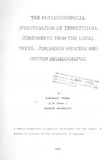| dc.description.abstract | For many years various methods have been employed to control termite and prevent damage by termites on buildings, trees and other plants. Termiticides of various kinds have been used but there has been a general concern worldwide about the environmental problems associated with these insecticides. One alternative for termite control was the use of wood extract from trees and herbaceous plants.
Juniperus procera Hochat. (Family- Cupressaceae), an indigenous tree in Africa normally referred to as African pencil cedar tree and known for its durable wood, contained variable amounts of volatile oils from the extract of its heartwood. The dried wood was cut into pieces and then sawed into fine sawdust which was extracted by dry (destructive) distillation of wood method. In this case, the sawdust was heated in a large round bottomed flask into sample vials at various temperatures. These were stored in a refrigerator.
Termites were collected from colonies identified around the Chiromo area in Nairobi by excavating the nest and removing the termites together with the mould fungus and also by trapping. In trapping, a PVC pipe filled with damp soil and maize cobs was set near a nest for several days and the foraging termites collected into containers. The most prevalent species of termites in the area was Odontotermes Stercorivorus. Another species also used was Odontotermes
xii
mautanus.
The crude extract was bioassayed against the subterranean termite species, Odontotonnes Stercorivorus and Odontotermes mautanus. Various formulations (different percentages of the crude extract in distilled water) were made and their relative toxicity to the termites observed. The extract proved to be effective to both species It was apparent- that the level of toxicity increased with increased concentration of the extract with the undiluted extract having the highest level of toxicity.
A tree used for comparison purposes, Croton Megalocarpus (family - Euphorbiaceae) was less toxic to the termites. TLC analysis revealed that there were ten major components in the Juniperus procera tree extract while the croton tree extract had five major components. This was confirmed by gas chromatography. The components were isolated by column chromatography and analysed using Infrared, ultra violet and mass spectroscopy techniques. The extract contained more than 70% water which was removed by partitioning and using anhydrous sodium Sulphate. Acids were removed by sodium bicarbonate. The extract which was about 30% of the sawdust by weight was found to contain alcoholic and phenolic compounds together with acids. The compound cedrol, JLZ a tertiary tricyclic alcohol was found to be in the highest proportion in the extract. Other compounds isolated were cedrene and other closely related compounds. The fraction containing the compound cedrol proved to be
xiii
effective on the termites. Previous work done by Clarence and co-workers had shown this compound to contain termiticidal properties. It had also been found to constitute a large proportion of cedar wood oil.
The use of these naturally occurring tree extracts would provide cheap and environmentally clean alternatives in controlling termites. This can be used as a part of the integrated pest management (IPM) while more research is done on the components (active ingredients) of the extract. The use of the extracts of such tree like the Cedar is a field open for more research and holds an important future in the control of pests. | en |

